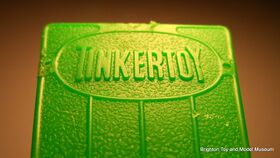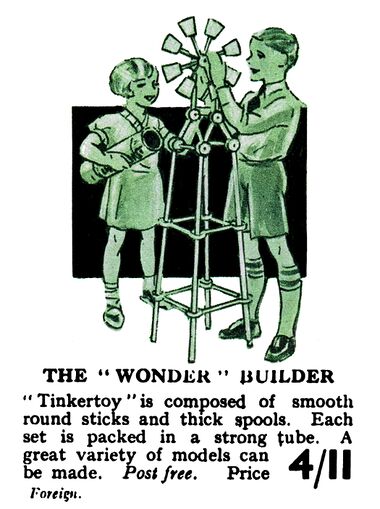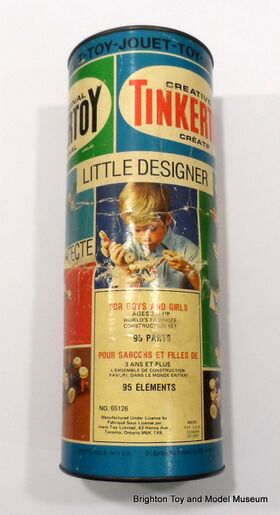Category:Tinkertoy
| Toy Brands and Manufacturers |
|---|
Tinkertoy |
| 1914 - |
1932: Gamages catalogue entry [image info]
Tinkertoy "Little Designer" outfit 66126 [image info]
The Tinkertoy system was patented in 1914 by Charles H. Pajeau of Evanston, Illinois, and was legendarily inspired by Pajeau's observation of the fun that children had playing with wooden reels and pencils (a long-running staple of magazine and encyclopedia articles on "toys to make at home"), and together with fellow Chicago train commuter Robert Pettit, Pajeau founded The Toy Tinkers Company to manufacture the new toy.
The trademarked "Tinkertoy" eventually became a part of American culture, and entered the language as a word to describe makeshift-looking structures with protruding pieces at odd angles, and/or movable or replacable parts.
Packaging
One of Pajeau's innovations that gave Tinkertoys a distinctive identity that set it apart from other wooden peg-and-block system was the packaging. Where most construction toy systems came in rectangular boxes with inserts to keep the parts separate, Pajeau reckoned that in order to be able to send the sets via mail order it was more efficient (and probably cheaper) simply to use existing heavy-duty postal tubes and pour the contents inside, with a glossy artwork paper sticker on the outside. Some of the earliest packaging even had a blank postal address panel pre-printed printed on artwork so that the robust tube wouldn't even need to be wrapped before posting.
Function
Pajeau produced a system of wooden rods and drilled reels that push-fitted together to make scaffolding-type structures, and a "special" reel with a larger central hole to allow it to rotate freely as a wheel. The use of reel-shaped joining pieces inspired users to think of making abstract structures with moving parts such as windmills, rather than just static towers.
Reels had eight holes drilled around the edge, one every 45 degrees, and rod lengths were based on the "square root of two" ratio that appears in simple right-angled triangles, so that one could make 45-degree right-angled grid using any two consecutive sizes of rod, and also mix and match different scales of grid.
The wheel could have spokes fitted to create a large gearwheel, and complicated systems could be built with protruding rods that moved other rods and mechanisms, making Tinkertoys an inspiration for the home inventor wanting to create elaborate "Heath-Robinson"-type structures.
Computing
The ability to build frameworks with rotating interacting parts (and the low cost of parts) encouraged a number of educational projects to build simple demonstration analogue computing devices from Tinkertoy parts, similar in concept to Charles Babbage's (far more expensive!) precision-engineered brass-geared calculator. If one was going to make a Babbage-type device to demonstrate abstract computing principles, the appeal of making it out of parts designed for a children's toy was probably irresistible (similarly, the casing for Google's initial server was supposedly made out of Lego).
External links
- How Tinkertoys Got Started (appalachianhistory.net)
- Tinkertoys: A toy for the ages, born and raised in Evanston (playgroundprofessionals.com)
- 100 Years of Tinkering (museumofplay.org)
- Evanston History Center "The home of Tinkertoys" (evanstonhistorycenter.org)
- Tinkertoys (burlingamepezmuseum.com)
- Tinkertoys (fabtintoys.com)
Pages in category ‘Tinkertoy’
This category contains only the following page.
Media in category ‘Tinkertoy’
The following 4 files are in this category, out of 4 total.
- Little Designer outfit (Tinkertoy 66126).jpg 870 × 1,600; 1.05 MB
- Tinkertoy (GamCat 1932).jpg 1,398 × 1,873; 934 KB
- Tinkertoy No146 GRAD outfit, tube.jpg 2,000 × 736; 993 KB
- Tinkertoy plastic piece.jpg 1,600 × 900; 802 KB








